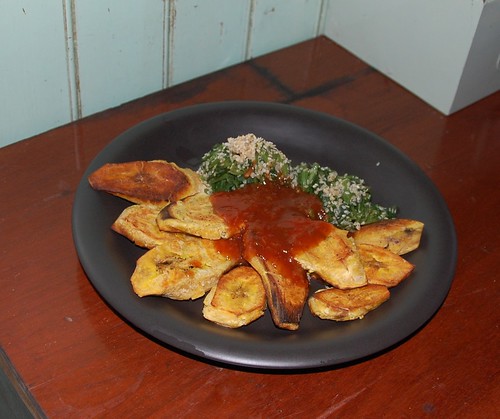Virginie mentioned in comments that there is an online resource for buying vegan products in France and in case it was missed I thought I'd mention it again in an update.
Un Monde Vegan
sells many of the products like Plamil and Redwood that are available in the UK and also has some ranges that are new to me. Not tried them yet but they look good.
Monday, June 28, 2010
Thursday, June 24, 2010
Almond Milk Meal
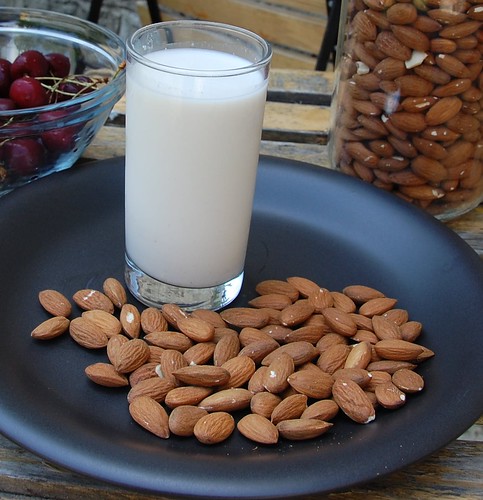
Almond milk is great stuff and reasonably easy to obtain in France but like anything bought preprepared you can never be exactly certain what's in it or have total control over the final product.
It's also something I've been meaning to try to make for really rather a long while.
To make about 450ml or so of almond milk you need 150g of whole almonds, with their skins on. Rinse them well and then cover with fresh water and soak overnight in the fridge - try not to leave them more than 12 hours.
Drain off the soaking water, put the almonds into the blender along with 600ml of fresh clean water and blend until smooth. Then all you do is strain the liquid through a fine mesh sieve or some cheesecloth. Squeeze the pulp to extract all the liquid.
At this point you can add sugar, flavourings like vanilla or a tiny pinch of salt to enhance the almondy taste. Beat the additions in well (or return to the blender) until dissolved and then chill the milky fluid before using in drinks or cooking. I chose not to flavour the bulk of my almond milk although I did flavour a small portion with some strawberry syrup to make a mini milkshake.
Stored in the fridge the milk may start to settle out but it's easy to quickly stir it back together again when needed.
And then you're left with about 250g of almond pulp. This can be used in cakes but I wanted to try something more savoury and decided to use the almond debris as if it were ground chickpeas. I made felafel.
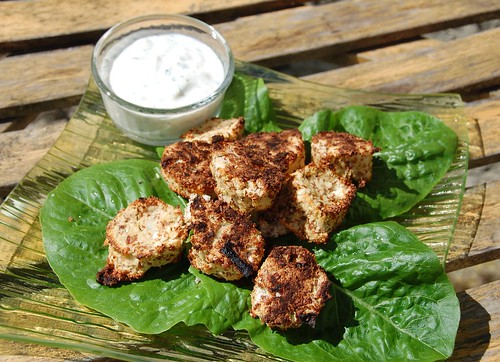
Add to your almond meal a finely chopped onion, as many minced green herbs like parsley and coriander as you can find (I couldn't find any!) and a teaspoonful of cumin seeds. Ground pepper and salt to taste, you might also add a little cayenne pepper or even a finely chopped chilli to the mix.
Form the mixture into small balls or disks. My technique is take just enough mixture to make a coin sized cake about 1cm deep in the circle formed by my forefinger and thumb on the right hand, using the left hand to compress the mixture into the shape, which makes it sound far more complicated than it is.
Place each felafel onto a well oiled tray, you'll get about 16 out of this many almonds, and then bake in a hot oven, say 220C, for 20 to 25 minutes until golden. They are a little fragile but should, if the tray was well greased enough, be strong enough to remove on to bread or salad for serving.
I won't lie, baked like this they are a little dry and worthy, next time I'll try deep frying them as I do for the chickpea version but with a well flavoured sauce to moisten them they are a very healthy and enjoyable foodstuff, serving as part of a mezze table, as a starter for 3 or 4 or a main course for two.
Use a traditional tahini based lemon and garlic sauce, a mint raita (as I have done here) or put them in a mixed salad with plenty of oily vinaigrette.
Wednesday, June 23, 2010
Bread Salad
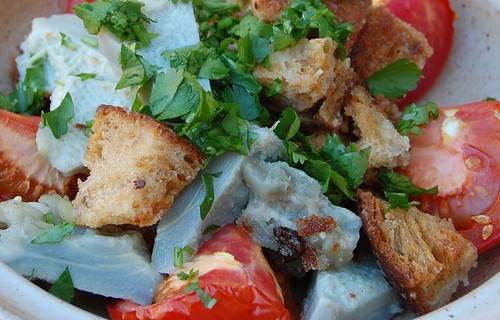
Bread salads seem to have been popping up all over the place in the last few days and who am I to buck a trend?
I had two magnificent globe artichokes, one of which was destined for a simple vinaigrette, the other to be gratinéed. In the end though, simple greed won over. Rather than work my way parsimoniously through the scrag ends of bracts I decided to cut straight to the chase and whip out their hearts. I have, dutifully, put the leaves in the fridge because I might fancy them tomorrow but tonight I have dined comme une gourmande if my French hasn't failed me. It often does.
Cook your artichokes in a large pan of water, nicest if you have a half of lemon in the water. You'll need to simmer them for about 40 minutes or until a lower leaf, gently tugged detaches easily from the head. Drain and allow to cool.
Make garlic croutons with slightly stale bread, torn or cut into bite sized pieces. Toss the bread cubes in good olive oil, sprinkle with finely chopped garlic and place in hot oven until crisped and golden.
At the same time, pop a few quarters of good ripe tomato into the oven, this really helps to concentrate the still feeble flavour of the early season tomatoes and encourage them to combine more readily with the rest of the cooked ingredients.
Deleaf and dechoke your artichoke. Removing the leaves is easy and I use a teaspoon to gently pull away the choking immature florets. If you look closely at the picture you can see tiny dimples where each little clump of hairs has detached. Rinse briefly and divide each heart into eight or ten pieces. You can also harvest a little edible pulp from within the thickly fibrous stem.
Douse your artichoke bits in lashings of lemon juice. I know it's only a couple of days since I was bitching about too much acid in the food, but I reserve the right to be inconsistent. Artichoke hearts demand lemon.
Mix the croutons with the hearts, dress a plate with the tomato quarters and pile the mixture within. Sprinkle with chopped green herbs of your choice and a little salt and pepper if liked. Allow to sit for 20 minutes, no more, to blend the flavours, garlicky, lemony, herby and then eat as quickly as you can. Leave it too long and all the crispness of the croutons is lost.
I forgot to take a picture of my artichokes before I prepared them so here's one I took another time.
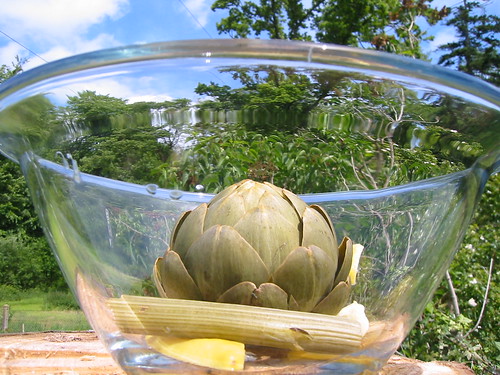
Tuesday, June 22, 2010
Sumer Is Icumen In
It's finally got hot here in Normandy and I'm loving it. The new vegetables are beginning to be available in serious quantities and warmth is conducive to leisurely meals sur l'herbe, it's picnic time.
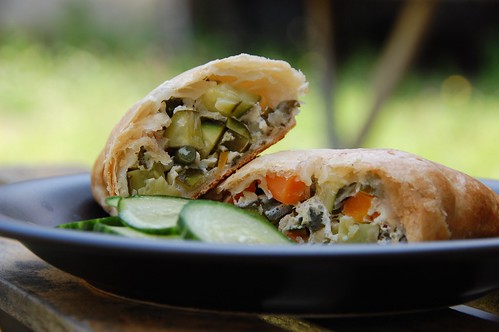
Today I made some pasties, but not your tired old root veggies and onions. These are packed full of the best baby vegetables the garden could offer, tiny broad beans, courgettes no longer than my finger, the scape of an elephant garlic chopped fine, new carrots and fresh green coriander all bound together with a whisper of soy yoghurt and held within a crisp coat of flaky pastry.
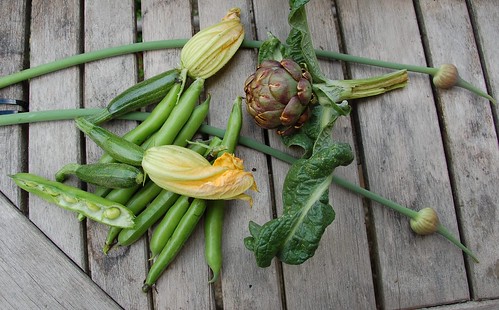
Chop your babies fine and there will be no need to steam or pre cook them in anyway. Allium scapes, despite looking deliciously crisp all the way down do start to get tough at the root end. Start with the flower and work down stopping as soon as there starts to be some resistance to the knife.
I swapped carrots for the baby artichoke in the picture. Our artichokes grown in the chilly north of France tend to coarsen quickly and I most often use them in a pottage of herbs and potatoes where they can be cleanly pared and checked for toughness before they reach the mouth.
Mix your vegetables with a minimum of soy yoghurt or leave it out altogether. If you don't use it consider adding a teaspoon of lemon juice or extra herbs, dill might be good with these.
Pastry, I used ready made but make your own by all means. Roll it out to a circle and divide into quarters, spoon a little filling on to each and fold the pastry over sealing the edges tightly. Make a small steam hole in the top of each and bake at about 200C for 25 to 30 minutes. The vegetables will be just cooked and the pastry lightly golden.
Seasoning, there was none, relying on the delicate flavours of the vegetables and coriander, but you might sprinkle in a little aromatic black pepper if you like it.
To serve, English Cucumber salad, simply sliced cucumbers (not my own unfortunately) sprinkled with pinch of salt and a tad of white vinegar before being allowed to wilt in its own juice for an hour.

Today I made some pasties, but not your tired old root veggies and onions. These are packed full of the best baby vegetables the garden could offer, tiny broad beans, courgettes no longer than my finger, the scape of an elephant garlic chopped fine, new carrots and fresh green coriander all bound together with a whisper of soy yoghurt and held within a crisp coat of flaky pastry.

Chop your babies fine and there will be no need to steam or pre cook them in anyway. Allium scapes, despite looking deliciously crisp all the way down do start to get tough at the root end. Start with the flower and work down stopping as soon as there starts to be some resistance to the knife.
I swapped carrots for the baby artichoke in the picture. Our artichokes grown in the chilly north of France tend to coarsen quickly and I most often use them in a pottage of herbs and potatoes where they can be cleanly pared and checked for toughness before they reach the mouth.
Mix your vegetables with a minimum of soy yoghurt or leave it out altogether. If you don't use it consider adding a teaspoon of lemon juice or extra herbs, dill might be good with these.
Pastry, I used ready made but make your own by all means. Roll it out to a circle and divide into quarters, spoon a little filling on to each and fold the pastry over sealing the edges tightly. Make a small steam hole in the top of each and bake at about 200C for 25 to 30 minutes. The vegetables will be just cooked and the pastry lightly golden.
Seasoning, there was none, relying on the delicate flavours of the vegetables and coriander, but you might sprinkle in a little aromatic black pepper if you like it.
To serve, English Cucumber salad, simply sliced cucumbers (not my own unfortunately) sprinkled with pinch of salt and a tad of white vinegar before being allowed to wilt in its own juice for an hour.
Friday, June 18, 2010
One from the vaults
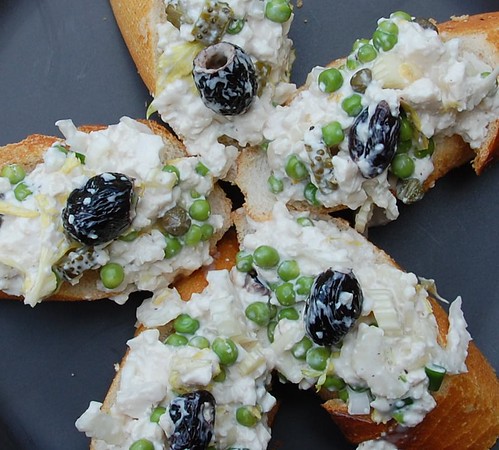
There have, in recent days, been a few recipes that I've noted for further investigation. Well, what am I saying, I have a list of such recipes as long as the arms and legs of several octopuses (I feel sure that should be octopi) but what I meant was that several have bubbled up to the top and made me think I should give them a go immediately.
So, after only 16 days, I've actually tried one of them. I give you Piquant Tofu Salad with Peas and Scallions which I found on the Threemanycooks blog. Apparently it's from a recipe book I don't have "The Kind Diet by Alicia Silverstone".
Anyway, it sounded just my sort of thing and I've been looking for a cool high protein tasty inclusion for hot summer day meals. Unfortunately I'm disappointed. It's o.k. and it's possible that the substitutions I had to make for missing ingredients like umeboshi vinegar just weren't up to scratch but I doubt it - I'm familiar with all the items I substituted and really don't think that's the problem. The recipe called so much salt and acid (from olives, capers, the plum vinegar, lemon juice) to flavour the tofu and peas that one might have been eating cardboard.
So call this one a fail, but by all means give it a go if you like the basic idea - it is, after all, extremely low fat and nutritious and might go well in a sandwich with a lot of fresh green leaves to offset the over seasoning.
Wednesday, June 16, 2010
Really Living in France as a Vegan
Lauren asked in comments if I could write a bit about managing to stay vegan in France. It is difficult but not impossible as there are a number of useful resources available.
Of course, if you're able to cook for yourself (and poor Lauren will have no kitchen) there are plenty of vegetables, bread and pulses available to make meals with. Also, in most of the supermarkets there is a range of 'health foods' in a designated area which usually include a very firm tofu, soy creams, animal free spreads, almond milk, nutritional yeast and so on. The brands to look out for are Bjorg and Gerber. Read the labels, not everything is vegan.
Soy milk may be found in these aisles but is quite often stocked near the other boxed milks - the French are quite happy with long-life milk and there is usually a bigger selection of this than fresh milk. Shelf stockers find that long life soy milk has a natural home here.
In the chilled cabinets you will find margarines suitable for vegans, 100% végétal but you're unlikely to find any soy cheese substitutes, the average French consumer would roll their eyes in horror at the thought of it. There are also, if you're lucky and can search them out, products from the Sojasun range. These include burgers, soy based puddings and plain soya yoghurts. There are no fake sliced meats that I've ever seen. In the freezer cabinets some sorbets are vegan and I have, once, seen dairy free ice cream.
If you're looking for ready made pastry, choose the cheaper end of the range which will be made with (usually unidentified) vegetable fat which you must make your own mind up over. More expensive sorts will proclaim their content of pure butter. Brik pastry is vegan and much more easily found than filo. It can be used in much the same way.
Nuts, olives and seeds can often be found in the vegetables section of the supermarket. Oats are for breakfast, Quaker is usually available, less processed oats and mixed grain cereals sometimes found. Quinoa, polenta and speciality flours are on the shelves somewhere near the baking section usually.
Ordinary bread will be fine but of course, all the croissants, brioches and enriched doughs are packed full of butter and sometimes eggs, so have to be avoided. I've never found a vegan patisserie either, so avert your eyes from the beautiful displays of tarts and cakes. Some supermarkets carry decent levain raised breads but if you're in town try all the bakers to see which one does the sort of bread you like.
There are health food shops - not all of them good, our local one in St. Lo started well but has now drifted off into high protein whey supplements and herbal bathsalts. Also, beware, many of the items in the chilled cabinet are to organic standards but are not even vegetarian. Read the labels carefully. You might be lucky, we have found some interesting products in places like this, unfortunately, supply seems to be rather hit and miss and they're often no longer stocked when you go back for more.
A useful resource for finding local organic produce is here, plug in your area for names and locations of shops near you. These are the Normandy ones and these the Pays de la Loire.
Eating out can be difficult. The best plan is to politely ask for food without animals products for your health. There is general understanding of the need for health related food preferences, almost none from an ethical point of view. Even so, you will have to fend off offers of cheese, eggs or even ham as they're considered to be barely from animals at all, and are often automatically included in salads and sandwiches. Of course, your success will depend mostly on how good your spoken French is, but I've never yet been chased from a restaurant for ordering a green salad and chips, although it does get some funny looks.
There are some alternative cuisines available in the bigger towns. Pizza is an option most places and can be ordered cheeseless, Chinese food is quite often available but they're less likely to have veg*n options on the menu than in English speaking territories as there's little call for it in France. Cous cous houses often have a vegetable couscous, it's taking a bit of a chance on the kitchen that it's purely vegetables but in desperation we have eaten in these places (and enjoyed it!). In this part of France there is almost nothing that can be described as a vegetarian or vegan restaurant. I have heard of a cafe in Caen that has some veggie options and there is an English run resto some 3 hours drive away that opens during the season. Rural France isn't Paris!
And there are French vegans! Virginie writes at Absolutely Green and links to many more. There is a French vegetarian society with a website here and most of the ex-pat communities will have contacts for veggies and information to share.
So it can be done, but as vegans everywhere know it takes constant vigilance and some good luck. Bonne chance.
Of course, if you're able to cook for yourself (and poor Lauren will have no kitchen) there are plenty of vegetables, bread and pulses available to make meals with. Also, in most of the supermarkets there is a range of 'health foods' in a designated area which usually include a very firm tofu, soy creams, animal free spreads, almond milk, nutritional yeast and so on. The brands to look out for are Bjorg and Gerber. Read the labels, not everything is vegan.
Soy milk may be found in these aisles but is quite often stocked near the other boxed milks - the French are quite happy with long-life milk and there is usually a bigger selection of this than fresh milk. Shelf stockers find that long life soy milk has a natural home here.
In the chilled cabinets you will find margarines suitable for vegans, 100% végétal but you're unlikely to find any soy cheese substitutes, the average French consumer would roll their eyes in horror at the thought of it. There are also, if you're lucky and can search them out, products from the Sojasun range. These include burgers, soy based puddings and plain soya yoghurts. There are no fake sliced meats that I've ever seen. In the freezer cabinets some sorbets are vegan and I have, once, seen dairy free ice cream.
If you're looking for ready made pastry, choose the cheaper end of the range which will be made with (usually unidentified) vegetable fat which you must make your own mind up over. More expensive sorts will proclaim their content of pure butter. Brik pastry is vegan and much more easily found than filo. It can be used in much the same way.
Nuts, olives and seeds can often be found in the vegetables section of the supermarket. Oats are for breakfast, Quaker is usually available, less processed oats and mixed grain cereals sometimes found. Quinoa, polenta and speciality flours are on the shelves somewhere near the baking section usually.
Ordinary bread will be fine but of course, all the croissants, brioches and enriched doughs are packed full of butter and sometimes eggs, so have to be avoided. I've never found a vegan patisserie either, so avert your eyes from the beautiful displays of tarts and cakes. Some supermarkets carry decent levain raised breads but if you're in town try all the bakers to see which one does the sort of bread you like.
There are health food shops - not all of them good, our local one in St. Lo started well but has now drifted off into high protein whey supplements and herbal bathsalts. Also, beware, many of the items in the chilled cabinet are to organic standards but are not even vegetarian. Read the labels carefully. You might be lucky, we have found some interesting products in places like this, unfortunately, supply seems to be rather hit and miss and they're often no longer stocked when you go back for more.
A useful resource for finding local organic produce is here, plug in your area for names and locations of shops near you. These are the Normandy ones and these the Pays de la Loire.
Eating out can be difficult. The best plan is to politely ask for food without animals products for your health. There is general understanding of the need for health related food preferences, almost none from an ethical point of view. Even so, you will have to fend off offers of cheese, eggs or even ham as they're considered to be barely from animals at all, and are often automatically included in salads and sandwiches. Of course, your success will depend mostly on how good your spoken French is, but I've never yet been chased from a restaurant for ordering a green salad and chips, although it does get some funny looks.
There are some alternative cuisines available in the bigger towns. Pizza is an option most places and can be ordered cheeseless, Chinese food is quite often available but they're less likely to have veg*n options on the menu than in English speaking territories as there's little call for it in France. Cous cous houses often have a vegetable couscous, it's taking a bit of a chance on the kitchen that it's purely vegetables but in desperation we have eaten in these places (and enjoyed it!). In this part of France there is almost nothing that can be described as a vegetarian or vegan restaurant. I have heard of a cafe in Caen that has some veggie options and there is an English run resto some 3 hours drive away that opens during the season. Rural France isn't Paris!
And there are French vegans! Virginie writes at Absolutely Green and links to many more. There is a French vegetarian society with a website here and most of the ex-pat communities will have contacts for veggies and information to share.
So it can be done, but as vegans everywhere know it takes constant vigilance and some good luck. Bonne chance.
Friday, June 11, 2010
Through the lens

Food photography is a funny business. While I was making this dinner of quinoa stuffed peppers and a Macedonian tomato gravy Mr. Stripey was playing with a wacky new wide angle lens he'd bought. I'm not sure it's quite the thing for food porn but it certainly gives a new perspective on the food we ate.
The peppers were rather ordinary in the end despite being packed full of green garlic from the garden, hot green chillies and plenty of oil, which was disappointing.
On the other hand the rather dull sounding tomato gravy, a thickened roux flavoured with paprika and tomato produced something that was easy, tasty and a useful new addition to the repertoire, winning the prize for supporting artist with ease.
Makalo, a very traditional part of Macedonian cookery doesn't have to be strongly tomato flavoured and can be used in a variety of ways; as a cook in sauce for 'meatballs' or vegetables, as a pour over sauce for baked dishes and as a dip for chips and fried food. You don't have to come from the north of England to enjoy gravy with your chips.
To make it you need:
3 tbsp bland vegetable oil
75g plain flour
750ml water or vegetable stock
1 clove of garlic, finely chopped or minced
100ml passata or other smooth tomato sauce (this item to taste)
1 tsp paprika (smoked is good)
salt and pepper
Heat the oil in a heavy pan and sprinkle in the flour. Use a spoon to mix the flour into the hot oil and allow to cook gently, stirring continuously until the flour is just beginning to colour up and smell toasty. Add the garlic and combine.
Add the stock in small increments stirring all the time, just enough in each addition that the roux mixture sucks it all up before you add the next splash. Done carefully this should allow you to make a sauce with no lumps but if you're unlucky just get your whisk out and smooth those lumps away.
Add the passata and seasonings, stir well and allow to simmer gently, stirring frequently, for at least 10 minutes to ensure the flour is completely cooked through. Add extra stock if necessary to get the thickness you prefer. Check the seasoning, this shouldn't be overpoweringly strongly flavoured but does need a touch of salt to make it good.
Next time I think I'll cook the peppers in the sauce instead of separately as I did here.

Thursday, June 10, 2010
Wednesday, June 09, 2010
The usual excuses

Erm, not being a very good blogger am I? Been writing this blog for over 3 years now and I think I'm running out of steam.
Tonight's rather glum dinner, chickpeas with cumin and tomatoes, chilli without the kidney beans. Nice enough but exceptionally dull.
We'll have to see how this blogging thing goes - it might be time to retreat back under my stone again.
Subscribe to:
Posts (Atom)
